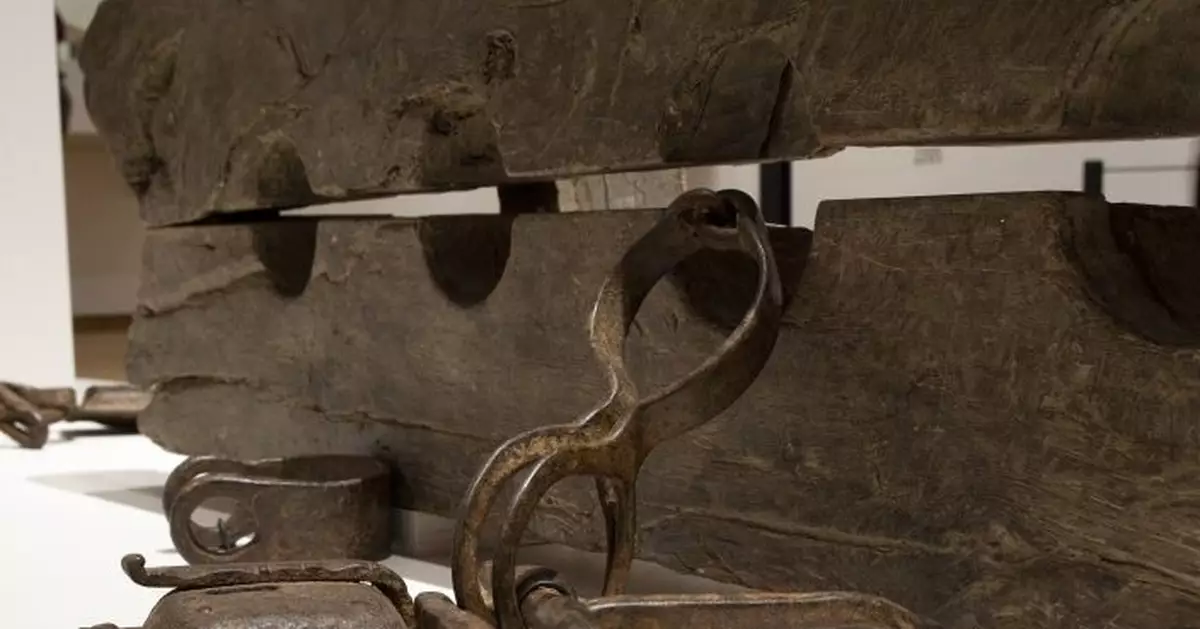The delicacy of one of the first objects in new exhibition at Amsterdam's Rijksmuseum belies its brutality. At the end of a thin iron rod are the artistically interwoven letters GWC — used to brand the initials of a Dutch trading company into the skin of enslaved workers.
The stark contrast between finery and brutality, wealth and inhumanity is a recurring pattern at the museum's unflinching exhibition titled, simply, “Slavery,” that examines the history of Dutch involvement in the international slave trade.
Nearby, a huge wooden set of stocks and heavy iron chains and locks used to constrain enslaved people stands close to a small box, intricately decorated with gold, tortoiseshell and velvet celebrating some of the valuable commodities traded by the Dutch West India Company in the 18th century: Gold, ivory and human beings.
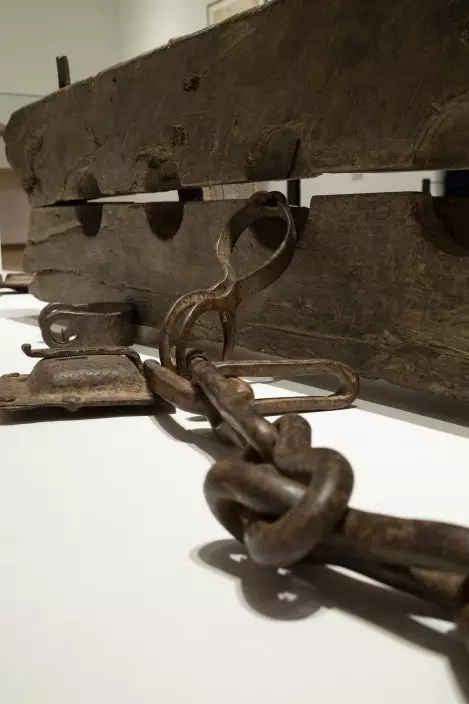
Tronco, or multiple foot stocks used to to constrain enslaved people, are seen at the Slavery exhibition Rijksmuseum in Amsterdam, Netherlands, Monday, May 17, 2021. The stark contrast between finery and brutality, wealth and inhumanity is a recurring pattern at the museum's unflinching new exhibition titled, simply, "Slavery", that examines the history of Dutch involvement in the international slave trade. (AP PhotoPeter Dejong)
The exhibit, being opened Tuesday by King Willem-Alexander, tells the story of slavery by drilling down into the personal stories of 10 people, ranging from enslaved workers to a wealthy Amsterdam woman.
“We wanted to make the case, that this is a history that speaks to anybody in the Netherlands. It belongs to all of us, so that’s why we chose a personal approach," Valika Smeulders, head of the museum's history department, told The Associated Press.
The exhibition opens — belatedly and mainly online because of the COVID-19 pandemic — at a time when scrutiny of many nations' brutal colonial history has been spurred by the Black Lives Matter movement that swept the world last year after the death of Black man George Floyd.

Tronco, or multiple foot stocks used to to constrain enslaved people, are seen at the Slavery exhibition Rijksmuseum in Amsterdam, Netherlands, Monday, May 17, 2021. The stark contrast between finery and brutality, wealth and inhumanity is a recurring pattern at the museum's unflinching new exhibition titled, simply, "Slavery", that examines the history of Dutch involvement in the international slave trade. (AP PhotoPeter Dejong)
School children will be able to visit the museum beginning this week, but the exhibition will not open to the general public until the Dutch lockdown eases further, possibly in June.
Amsterdam had a significant role in the global slave trade — the stately mansions lining its canals attest to the fortunes made by Golden Age traders often with the use of slave labor. That history has led to calls for a formal apology from the current municipality.
“Well, apologies are in the air, absolutely. And I think that, with this exhibition, as a museum, what we are adding to that is that we bring this story in the most honest way possible for us at the moment," said Smeulders.
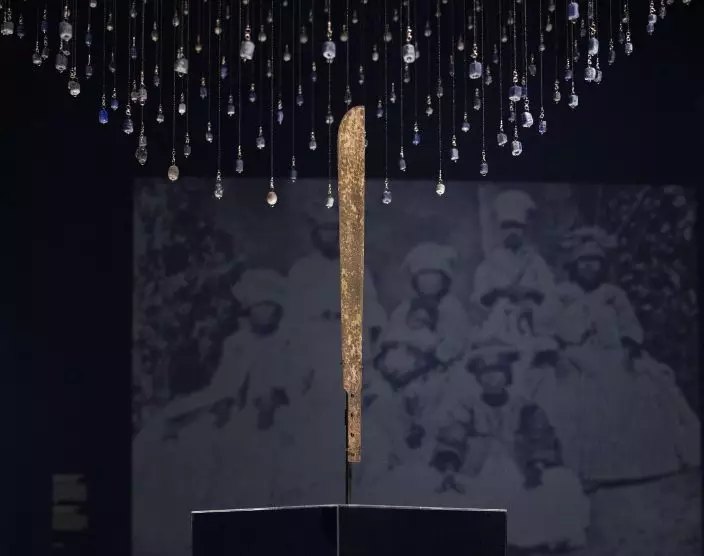
A machete used for cutting sugar cane is displayed at the Slavery exhibition Rijksmuseum in Amsterdam, Netherlands, Monday, May 17, 2021. The stark contrast between finery and brutality, wealth and inhumanity is a recurring pattern at the museum's unflinching new exhibition titled, simply, "Slavery", that examines the history of Dutch involvement in the international slave trade. (AP PhotoPeter Dejong)
The Dutch show is part of a broader movement to re-examine colonial histories. In neighboring Belgium, the Africa Museum near Brussels re-opened a few years ago after a major renovation and shone a light on the country's dark colonial history in Congo.
Germany is returning hundreds of artifacts known as the Benin Bronzes that were mostly looted from West Africa by a British colonial expedition.
The 10 stories featured in the Amsterdam exhibition span 250 years of Dutch colonial history and four continents — Europe, Asia, South America and Africa.
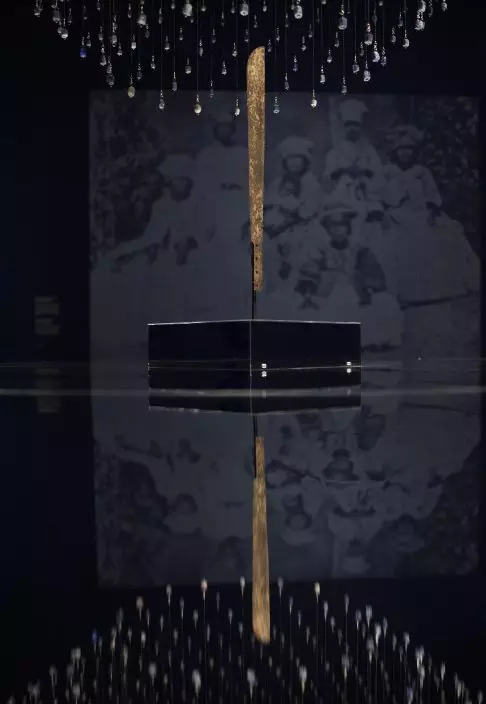
A machete used for cutting sugar cane is displayed at the Slavery exhibition Rijksmuseum in Amsterdam, Netherlands, Monday, May 17, 2021. The stark contrast between finery and brutality, wealth and inhumanity is a recurring pattern at the museum's unflinching new exhibition titled, simply, "Slavery", that examines the history of Dutch involvement in the international slave trade. (AP PhotoPeter Dejong)
Among the stories is that of Wally, an enslaved man forced to work on a sugar plantation in the colony of Suriname. In an audio presentation, his history is narrated by former kickboxing world champion Remy Bonjasky, whose ancestors worked on the same plantation.
Wally became involved in a conflict with the managers of the plantation in 1707. He and other enslaved people fled before they were recaptured, interrogated and executed.
Wally and his fellow escapees “were to have their flesh torn off with red hot pincers while being burned alive,” Bonjasky says in the online narration. “Their severed heads would later be displayed on spikes as a warning.”
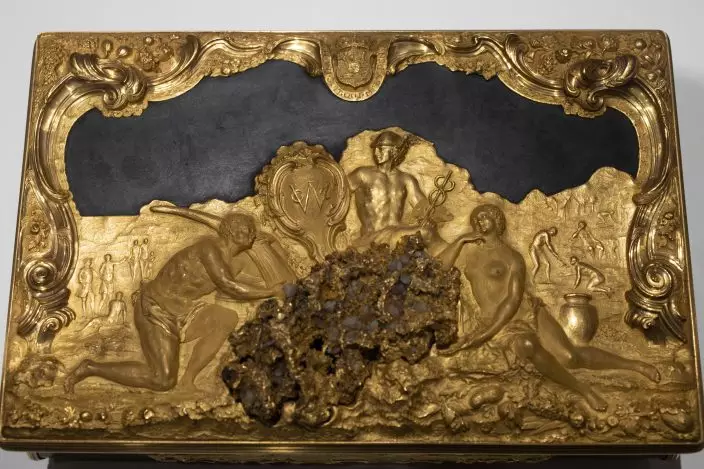
A box gifted to Stadholder William IV as the new governor of the Dutch West India Company (WIC) with decorations referring to the WIC's trade in gold, ivory and people, is displayed at the Slavery exhibition at the Rijksmuseum in Amsterdam, Netherlands, Monday, May 17, 2021. The stark contrast between finery and brutality, wealth and inhumanity is a recurring pattern at the museum's unflinching new exhibition titled, simply, "Slavery", that examines the history of Dutch involvement in the international slave trade. (AP PhotoPeter Dejong)
The “might” shown by Wally and the other enslaved men “is still in my blood,” Bonjasky says. “It has been passed down through generations and is one of the reasons why I was able to become kickboxing world champion three times.”
Another story in the exhibition that provides a glaring contrast to the horror of Wally's short life is that of Oopjen Coppit, the widow of Marten Soolmans, whose father owned Amsterdam's largest sugar refinery, processing crops harvested by enslaved men and women in South America.
In the exhibition, she is a personification of the wealth generated for a privileged few by enslaved workers. In a full-length portrait painted in 1664 by Rembrandt van Rijn, she wears a long black, lace-trimmed dress accessorized a pearl necklace and earrings.
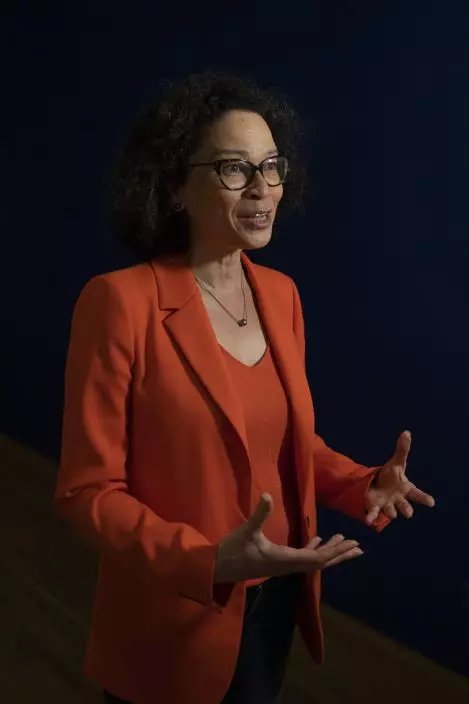
Curator and head of the history department of the museum, Valika Smeulders is interviewed at the Slavery exhibition Rijksmuseum in Amsterdam, Netherlands, Monday, May 17, 2021. The stark contrast between finery and brutality, wealth and inhumanity is a recurring pattern at the museum's unflinching new exhibition titled, simply, "Slavery", that examines the history of Dutch involvement in the international slave trade. (AP PhotoPeter Dejong)
“That we’re able to use Rembrandt to speak about the history of slavery is really exciting and really new,” Smeulders said.
Oopjen's second husband, Maerten Daey, also had links to the slave trade. Before their wedding, he served as a soldier with the Dutch West India Company in Brazil, where he kidnapped and raped an African woman called Francisca, fathering a daughter in 1632, according to church records cited in the exhibition.
“The lives of Marten, Oopjen and Maerten are intertwined with the history of slavery,” Rijksmuseum Director Taco Dibbits says in an audio tour of the exhibition. “They owed their wealth to the slave labor in Brazil. It is an example of how the history of slavery and the history of the Netherlands are bound together.”

A branding iron with interwoven letters GWC, used to brand the initials of a Dutch trading company into the skin of its enslaved workers, is displayed at the Slavery exhibition at the Rijksmuseum in Amsterdam, Netherlands, Monday, May 17, 2021. The stark contrast between finery and brutality, wealth and inhumanity is a recurring pattern at the museum's unflinching new exhibition titled, simply, "Slavery", that examines the history of Dutch involvement in the international slave trade. (AP PhotoPeter Dejong)
Read all AP stories on racial issues at https://apnews.com/hub/Racialinjustice.
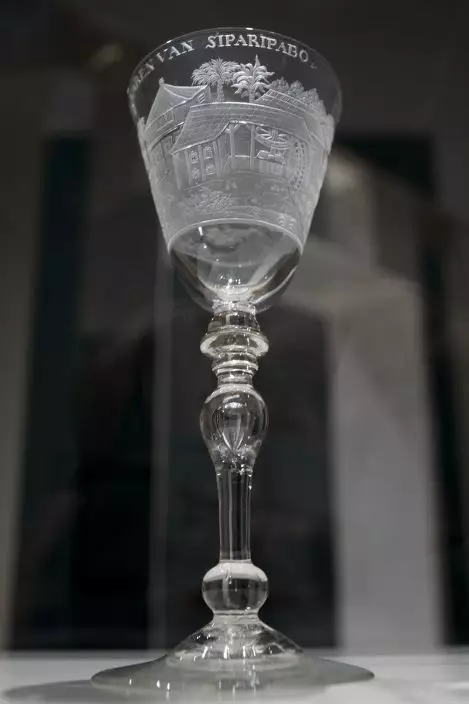
A ceremonial glass commissioned by plantation owners is seen at the Slavery exhibition at the Rijksmuseum in Amsterdam, Netherlands, Monday, May 17, 2021. The stark contrast between finery and brutality, wealth and inhumanity is a recurring pattern at the museum's unflinching new exhibition titled, simply, "Slavery", that examines the history of Dutch involvement in the international slave trade. (AP PhotoPeter Dejong)
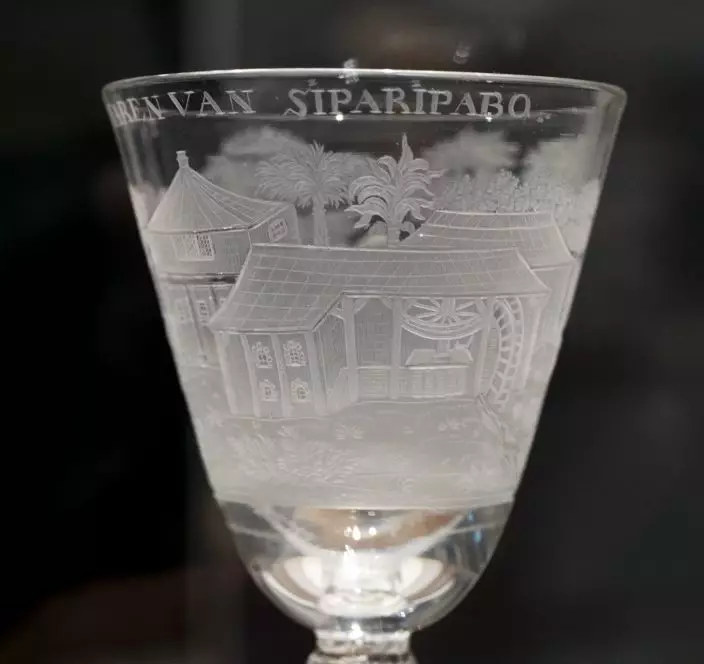
A ceremonial glass commissioned by plantation owners is seen at the Slavery exhibition at the Rijksmuseum in Amsterdam, Netherlands, Monday, May 17, 2021. The stark contrast between finery and brutality, wealth and inhumanity is a recurring pattern at the museum's unflinching new exhibition titled, simply, "Slavery", that examines the history of Dutch involvement in the international slave trade. (AP PhotoPeter Dejong)

The installation titled La Bouche du Roi, (The Mouth of the King), by Romuald Hazoume from the perspective of the millions of people deported from the west coast of Africa across the Atlantic Ocean to the Americas as commodities, is seen at the Slavery exhibition Rijksmuseum in Amsterdam, Netherlands, Monday, May 17, 2021. The stark contrast between finery and brutality, wealth and inhumanity is a recurring pattern at the museum's unflinching new exhibition titled, simply, "Slavery", that examines the history of Dutch involvement in the international slave trade. (AP PhotoPeter Dejong)
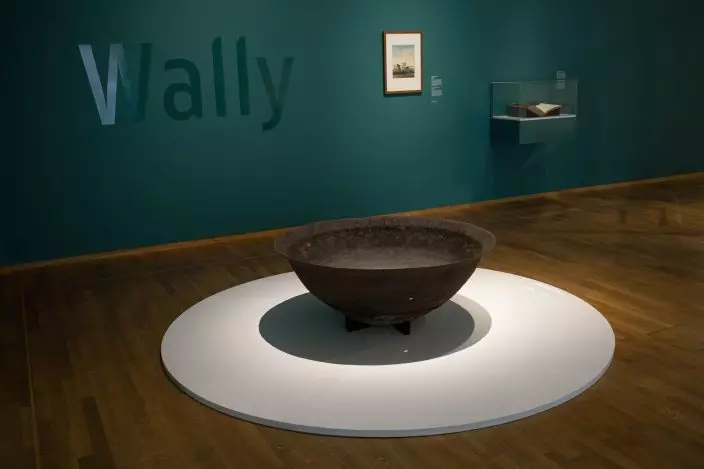
A huge cast iron kettle used to process sugar cane is on display at the Slavery exhibition Rijksmuseum in Amsterdam, Netherlands, Monday, May 17, 2021. The stark contrast between finery and brutality, wealth and inhumanity is a recurring pattern at the museum's unflinching new exhibition titled, simply, "Slavery", that examines the history of Dutch involvement in the international slave trade. (AP PhotoPeter Dejong)
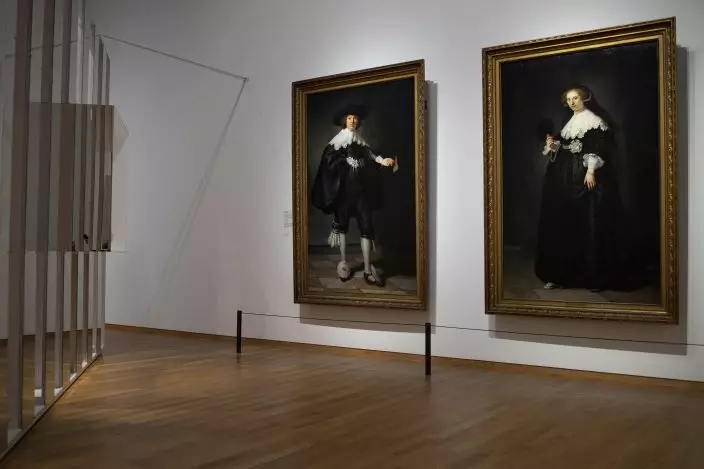
Oopjen Coppit, right, in a full-length portrait painted in 1664 by Rembrandt van Rijn, is seen at the Slavery exhibition at The Rijksmuseum in Amsterdam, Monday May 17, 2021. Coppit, was the widow of a man whose father owned Amsterdam's largest sugar refinery, processing crops harvested by enslaved men and women in South America. She is the personification of the wealth generated for a privileged few by the vast numbers of enslaved workers, and part of a pair of paintings that also included a depiction of her first husband Marten, left. (AP PhotoPeter Dejong)
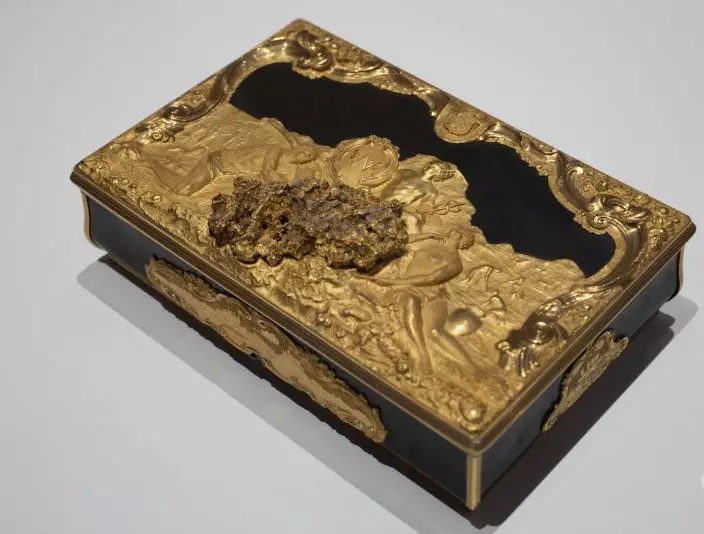
A box gifted to Stadholder William IV as the new governor of the Dutch West India Company (WIC) with decorations referring to the WIC's trade in gold, ivory and people, is displayed at the Slavery exhibition at the Rijksmuseum in Amsterdam, Netherlands, Monday, May 17, 2021. The stark contrast between finery and brutality, wealth and inhumanity is a recurring pattern at the museum's unflinching new exhibition titled, simply, "Slavery", that examines the history of Dutch involvement in the international slave trade. (AP PhotoPeter Dejong)


